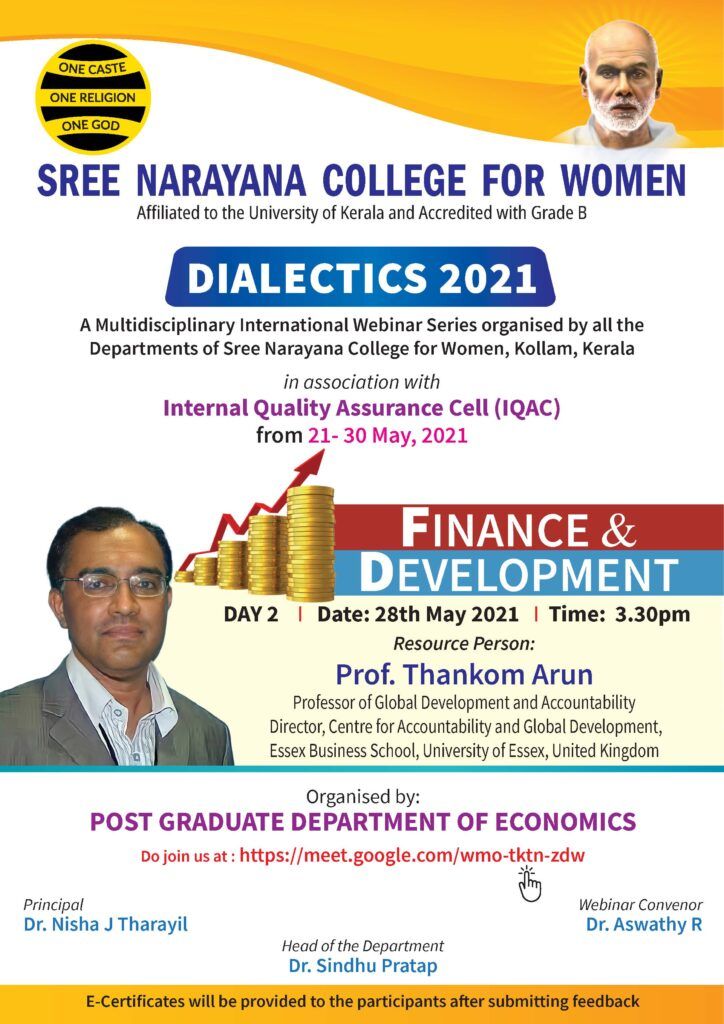A webinar by Prof. Thankom Arun for DIALECTICS 2021- A Multidisciplinary International Webinar Series organised by all the Departments of Sree Narayana College for Women, Kollam, Kerala in association with Internal Quality Assurance Cell (IQAC)
Prof. Thankrom Arun is the Professor of Global Development and Accountability Director- Centre for Accountability and Global Development, Essex Business School, University of Essex, United Kingdom
Key Takeaways
Fintech: Evolutionary to Revolutionary
There has been a shift in the understanding of finance and the market interactions by the modern society vis-a-vis the 20th century.
Traditionally, issues of finance have been seen in the context of financial intermediation, particularly in mobilising savings and managing risks. This gained momentum in 1950s among newly independent nations. However, in 1980s and 1990s, this witnessed severe criticisms for its restricting the nature and quality of financial intermediation. This was followed by a proposal for a liberalised trade regime.
The financial sector reforms in the late 1970s and 1980s were characterised by-
- Measures to promote competition in financial services
- Deregulation of interest rates
- Revamping of direct credit
While globalisation has had numerous positive effects, it has also opened the gates to numerous risks to the financial stability of the world economy; While keeping in mind the lessons from the past, necessary structures need to be put in place to create an environment that is structurally safe and thriving.
Modern Finance Features-
- Use of technology- enabling players to make complicated financial decisions and facilitating the end use of the product.
- Volatility- making financial market dynamic with more risk-based decisions; it influences investment and funding decisions as well.
- Introduction of a new era of financial instruments such as futures, options etc
- Regular innovations in the nature and design of financial products such as CDS. These new instruments have brought in a high degree of transparency and reduction in information asymmetry.
The transformation of finance industry has also generated a new breed of finance professionals, policy makers and academics who believe in the vibrant financial system rather than the narrow view of it.
Financial Inclusion and Microfinance
While exclusion can be voluntary or involuntary, the limited use of financial services in developing countries has become an international policy concern. Around 1.7 billion people don’t use formal financial services and more than 50% of adults in poorest households are unbanked.
The solution? An “inclusive” financial sector and microfinance. In order to move ahead, pro-poor growth is a necessity, both in absolute and relative terms.
Financial Inclusion
Definition
- All working age adults have effective access to credit, savings, payments and insurance from formal financial service providers.
Characteristics
- Access to financial services and reach of financial infrastructure
- Quality of products and service delivery; usage of services
Data sources
- Supply-financial service providers, mobile phone operators
- Demand- users of financial services such as individuals and firms
Research issues
- Borrower’s lack of information about own capabilities and inadequacies
- Negative perception, attitudes and behaviour
- Covariate risk of poor people
Microfinance
Definition
- A significant amount of private capital introduced into the sector.
Passage of entry
- Development Financial Institutions (DFIs)
- Individual and institutional investors
- Private Microfinance funds
Governance complexity
- Operational areas include gaps and lead to institutional voids in governance framework
- Time invariant structures fail to capture effect of governance in imperfect markets



